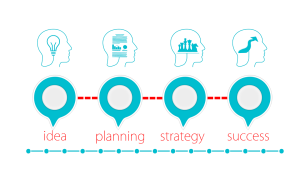For many professionals, career growth and career development are necessary for fulfilling personal and professional expectations. They are necessary for anyone who strives to climb the corporate ladder, achieve set goals, and reach top-rated positions. The labor market has changed drastically over the last few years, with the introduction of remote work, asynchronous collaboration, and the use of artificial intelligence [1]. Found at a professional crossroads, many individuals are seeking effective ways to enhance their employability and develop their skills (read more on the job vs career) [2]. One powerful approach is to identify and leverage personal strengths.
The HIGH5 strengths test offers a comprehensive assessment that helps individuals uncover their unique talents, providing a solid foundation for career growth and development. By understanding their innate strengths, professionals can make more informed decisions about their career paths and focus on roles that align with their natural abilities. In this article, we will distinguish career growth and career development and discuss different ways to increase your chances for promotion and success.
What is career growth?
What is career growth? Career growth is often confused with climbing the corporate ladder, but the definition of career growth has changed over time to encompass the multitude of directions you can follow in your career. Today, career growth is about leveraging your strengths, interests, skills, and values to achieve in your career, however you may define that [3]. It is quantitative, and it can be measured, i.e., you can see yourself going from an individual contributor position into a management position, or vice versa [4]. It can include moving from a time-intensive job to a career with more work-life balance. It can even mean growing out of your career into other areas of your life like retirement. Regardless of your goal, career growth is achieved through a multitude of factors.
These factors involve:
- Acquiring and utilizing new skills to help you reach your goals.
- Being employed by an industry leader can provide opportunities for professional advancement. This is usually a reciprocal process since everything that you have acquired can be used to promote the company, develop new products or ideas, and/or make an impact.
- Having an opportunity to overcome challenges successfully, handle new responsibilities, recognize and work on breakthrough concepts, and stand for and defend major decisions.
- Building strong connections through networking, where you can learn from and leverage the expertise of other professionals.
- Maintaining a growth mindset, and keeping yourself open to new opportunities.
There are tools like talent assessment test and similar tests that can help you discover your talents, strengths and traits that will help you in your career development. Having said this, one could see career growth based solely on merits and the ability to prove oneself worth having a promotion and better position. It means more responsibility, more personal involvement, and more reward. But, it could also depend on subjective opinions that might not always align with objective merits and achievements. Sometimes, workplace environments can be biased, and not anyone who deserves a new role has the opportunity to get it when they want it [5]. Therefore, it is crucial to know how to make yourself visible to people in your network and how to make an impact that will eventually lead to getting a well-deserved position.
Importance and benefits of career growth for employees
Career growth gives employees confidence and increases engagement, leading to higher job satisfaction [6]. It helps them build new skills, advance professionally and personally, and improve other areas of their life like earning potential or work-life balance. When career growth opportunities are available, it can also improve employee engagement and retention.
Importance and benefits of career growth for employers
Employers benefit from career growth by fostering a highly skilled workforce, increasing job efficiency, and becoming industry leaders [6]. Career growth paths attract top talent and help companies cultivate future leaders from within the organization. This investment also promotes loyalty and long-term organizational success.
Step-by-step guide for career growth
The following steps will help you develop a clear path to achieve long-term career goals.
Reflect
Before you decide on your career goals, take some time to self-reflect. Ask yourself questions about your career path thus far and how you want your career and life to look in the future. Asking yourself self-reflection questions can help you determine your interests, clarify a potential path, and identify barriers you may come across. Here are some questions you can ask yourself:
- What do you value at work? What do you value in life? How can you live both values?
- How do you define success? How do you define career success?
- If you can imagine your dream career, what would your day-to-day activities look like?
- What excites you?
- What are some projects and tasks you could do without?
- What are your deal breakers?
- What is important to you?
- What are your strengths?
- What skills do you want to continue using?
- What skills and education do you wish you had?
- Whose career path do you admire?
Set clear goals
The first step in career growth is setting specific, measurable, and achievable career goals. These should align with your long-term vision and can range from obtaining a particular job title to developing expertise in a niche area to creating a better work-life balance. Ask yourself when you want to meet your goal. How would you know you have reached your goal? Define your ultimate career growth goal using big questions like those mentioned above. Breaking down large goals into small, actionable steps helps maintain focus and track progress more effectively. When setting goals, use the SMART framework (Specific, Measurable, Achievable, Relevant, and Time-bound) to ensure they are clearly defined and practical.
Assess current skills
Once goals are set, evaluate your current skills to understand where you stand in relation to your career goals. This involves a thorough assessment of both your hard skills (technical expertise like coding, marketing, accounting, etc.) and soft skills (communication, creativity, leadership, etc.). Identify any gaps in skills that could prevent you from advancing, and seek feedback from peers, mentors, or supervisors to get a well-rounded view of areas for improvement and exploration. You can also conduct informational interviews with people whose careers you admire.
Seek learning opportunities
To bridge the gap between your current skill set and your career goals, pursue learning opportunities. This can include formal education such as certifications, workshops, or degree programs, informal learning like attending webinars, reading industry-specific materials, or participating in on-the-job training. Continuous learning ensures you stay current with industry trends and technological advancements, making you more competitive in the job market.
Network and find mentorship
Networking is a critical component of career growth, as building relationships with industry professionals can open doors to new opportunities. This is especially helpful if you are looking to pivot in your career. Attend industry events, join professional organizations, and engage with others on platforms like LinkedIn to expand your professional circle. You can also leverage informational interviews to learn about career paths and build connections in that area. Additionally, seek out a mentor – someone who has experience in your field and can offer advice, feedback, and support. Mentorship can provide valuable insights into overcoming career challenges and achieving your objectives more efficiently.
Track progress
Regularly tracking your progress is essential to ensure you stay on course toward achieving your career goals. Periodically review the milestones you’ve set, and assess whether your actions are yielding the desired results. Adjust your strategies as needed, whether that means setting new goals, developing additional skills, or seeking new networking opportunities. By consistently monitoring your development, you can maintain momentum and make informed decisions about your career trajectory.
9 additional ways and tactics for career growth
In addition to the 6 steps to growing your career, here are nine more strategies that can accelerate your career growth:
Embrace feedback and continuous improvement
Regularly seeking feedback from supervisors, colleagues, and mentors is crucial for career growth. Constructive criticism helps you understand areas for improvement that you may not have noticed on your own. Being open to feedback and proactively acting on it demonstrates a commitment to personal development. Once you set your career goals, ask for specific feedback from people within your network. Reflect on feedback and adjust your approach, whether it relates to work habits, communication, or leadership.
Develop leadership skills
Leadership skillsare highly valued in many organizations, even if you’re not in a formal leadership role. By cultivating skills like decision-making, conflict resolution, and team management, you develop yourself as a whole person and prepare yourself for future roles that require greater responsibility. Look for opportunities to lead projects, volunteer for leadership positions, or mentor others within your organization. Even small steps toward demonstrating leadership can position you for promotions and greater influence.
Build a personal brand
In today’s digital age, creating a strong personal brand is essential for career growth [7]. This includes curating a professional online presence, sharing thought leadership content, and showcasing your expertise through platforms like LinkedIn, blogs, or industry forums. A well-developed personal brand helps distinguish you from others in your field and can attract new career opportunities, collaborations, or clients. Ensure that your online profiles reflect your professional goals and accomplishments.
Take on stretch assignments
Stretch assignments are tasks or projects that push you beyond your current skill level or comfort zone. By taking on these challenges, you learn new skills and demonstrate to your organization that you are adaptable and capable of handling greater responsibilities. Volunteering for cross-functional projects, international assignments, or high-visibility tasks can broaden your experience and make you stand out to decision-makers in your company.
Cultivate emotional intelligence (EQ)
Emotional intelligence, or EQ, is the ability to understand and manage your own emotions as well as the emotions of others [8]. High EQ is linked to better leadership, teamwork, and conflict resolution, all of which are critical for career advancement [9]. By developing skills like empathy, self-awareness, and effective communication, you can build stronger relationships with colleagues, handle workplace challenges more gracefully, and position yourself as a trusted leader.
Speak up when an opportunity arises
When it comes to your career, you need to communicate your goals and aspirations to the right people. Having a manager, leader, or mentor who is aware of your goals and advocates for you to achieve your goals can be beneficial. They can stand up for you when you are not in the room and seek out opportunities for you that align with your career goals. If they’re unaware of your goals and intentions, the work they assign you may not align with your desires.
Speak up before opportunities arise
State your career expectations before any possibilities arise (learn more about career planning) to the right people. There are different ways you could do this, depending on your role in the company and your status. You might have made that clear when you had your initial job interview or when your position was reviewed, but that information is often forgotten. Inform your manager, another leader, or a mentor of your intentions before an opportunity presents itself. This way, your network is aware of your goals and they can find you opportunities that align. However, be careful not to make yourself too imposing or rude in expressing your growth determination.
Find out what training you need and pursue it
If you have a specific position in mind, then find out what additional qualifications you need for that job. Sometimes, it takes mentorship from a more experienced person, so if there’s someone you can look up to, talk to that person and learn from them. Never hesitate to ask questions and clear out everything that confuses you; this will help you learn along the way. While some positions may require formal qualifications like MBAs or new degrees, it’s equally important to focus on developing your innate strengths. The HIGH5 strengths test can be an invaluable tool in this process. By identifying your top strengths, you can target training and development opportunities that align with your natural talents. This strengths-based approach to skill development enhances your existing capabilities and helps you stand out in your field.
For instance, if the HIGH5 test reveals that one of your strengths is ‘Strategic Thinker,’ you might focus on advanced problem-solving courses or strategic management workshops to further hone this skill. Going back to school might scare you at first, but it is the only way to get the job you’ve always dreamt of. And nothing is too difficult if you truly want it, isn’t it? Other career paths don’t impose academic achievements, so you should always know in advance what kind of development you need to be qualified for the desired position. And finally, never underestimate experience and proficiency in doing a job, since they are valuable assets when applying for a new position.
Speak up before an opportunity arises
What’s even more recommended is to state your career expectations even before any possibilities arise (learn more about career planning). There are different ways you could do this, depending on your role in the company and the status you have there. You might have made that clear when you had your initial job interview or when your position was reviewed, but you must have realized that this information is usually ignored or seldom taken for granted.
Inform your manager that you are ready and willing to take up more responsibilities or that you expect to get that promotion. It won’t hurt anyone if you deliver a monthly report of all your completed projects, including a note of your expectations. However, be careful not to make yourself too imposing or rude in expressing your growth determination.
Find out what training you need and pursue it
If you have a specific position in mind, then find out what additional qualifications you’ll need for that job. Sometimes, it takes mentorship from a more experienced person, so if there’s someone you can look up to, talk to that person and learn from him/her. Never hesitate to ask questions and clear out everything that confuses you. First-hand learning is always best acquired when observed and guided.
While some positions may require formal qualifications like MBAs or new degrees, it’s equally important to focus on developing your innate strengths. The HIGH5 strengths test can be an invaluable tool in this process. By identifying your top strengths, you can target training and development opportunities that align with your natural talents. This strengths-based approach to skill development not only enhances your existing capabilities but also helps you stand out in your field.
For instance, if the HIGH5 test reveals that one of your strengths is ‘Strategic Thinker,’ you might focus on advanced problem-solving courses or strategic management workshops to further hone this skill. Going back to school might scare you at first, but it is the only way to get the job you’ve always dreamt of. And nothing is too difficult if you truly want it, isn’t it?
Other career paths don’t impose academic achievements, so you should always know in advance what kind of development you need to be qualified for the desired position. And finally, never underestimate experience and proficiency in doing a job, since they are valuable assets when applying for a new position.
Pro Tip From HIGH5
After taking the HIGH5 strengths test, create a personalized development plan that combines formal training with strengths-based learning. For each of your top strengths, identify one professional development activity (e.g., a course, workshop, or mentorship opportunity) that will help you leverage that strength more effectively in your current or desired role. This targeted approach ensures that your professional development efforts yield maximum results.
Step out of your comfort zone
We love our comfort zone. But, ask yourself: “Have you ever done anything substantial while being comfortable and relaxed?” Most likely, you haven’t, and that applies to your career growth as well. Getting out of your comfort zone means doing things that are either unfamiliar or challenging for you. Stepping out of a comfort zone will look different for everyone. Consider increasing your visibility by offering assistance or sharing new ideas. Volunteer in projects that appeal to you and make valuable points to help teams grow. Create business and personal relationships, and be friendly and helpful to your coworkers as their support and even recommendation can be invaluable at times.
You can take a look at our research on career change statistics created by our team of researchers, where we have included the latest data and trends in the scope of career change.
8 career growth examples
Changing job roles
Transitioning to a new role at the same level within the organization to gain new skills and experiences.
Job promotions
Advancing to a higher position with increased responsibilities and compensation, reflecting career progression.
Training programs
Participating in training or courses to improve competencies, leading to more advanced roles.
Mentorship
Engaging in mentor-mentee relationships to gain insights, advice, and guidance for career advancement.
Cross-departmental projects
Working on projects in other departments to diversify experience and develop broader organizational knowledge.
Job rotations and job swaps
Taking on a role in another team to develop skills and see a different side of the business.
Sponsorship
Finding a sponsor in your organization who can stick up for you when you are not in the room. Sponsors are usually people with power in an organization that can help you build your brand and reach your career goals, even if circles you are not already in.
Coaching
Hiring a professional coach can help you bring clarity to your career path by asking powerful, open-ended questions to help you find the answers within you.
Differences between career growth and development
Unlike career growth which is planned and strategic, career development is transformative, i.e., it defines all the changes that happen to you while you aspire to reach your goals [10]. Career development encompasses all the knowledge, skills, and experiences you acquire on your growth journey. It profoundly impacts your personality, attitudes, problem-solving approaches, and overall professional identity. The HIGH5 strengths test plays a crucial role in this developmental process by providing a framework for understanding your innate talents. By identifying and focusing on your top strengths, you can accelerate your career development in a way that feels authentic and energizing. For instance, if ‘Empathy’ is one of your key strengths revealed by the HIGH5 test, you might find that developing your emotional intelligence and conflict resolution skills comes naturally and contributes significantly to your overall career progression.
Pro Tip From HIGH5
Integrate your HIGH5 strengths into your daily work routine. Each week, choose one of your top strengths and consciously look for opportunities to apply it in your tasks and interactions. Keep a “strengths journal” to record how you used the strength and the positive outcomes it generated. This practice will help you become more adept at leveraging your strengths and demonstrate their value in your professional context.
Career growth FAQ
What is a career growth opportunity?
If your career path provides a growth opportunity, it means that you can develop new skills, improve your abilities, and take part in new experiences to become a professional in your own field. Career growth opportunities are key to job satisfaction, motivation, engagement, and, therefore, great job performance. It’s crucial for everyone who wants to advance in their careers and grow professionally.
What are the 6 stages of career growth?
The six stages of career growth are reflection, setting goals, assessing current skills, seeking learning opportunities, leveraging your network, and tracking progress.. Each stage represents a phase of professional development.
How can I improve my career growth?
You can improve career growth by setting clear goals, developing new skills, networking, seeking mentorship, and consistently pursuing new challenges or opportunities. Regularly evaluating progress and staying updated with industry trends also help.
What are career growth plans?
Career growth plans are structured outlines that define an employee’s career goals and the steps needed to achieve them. These plans often include skills development, mentorship, training, and performance milestones to track progress.
References:
- Thomas Bannon, M. (2023, June 22). How AI Is Changing The Future Of Work. Forbes. https://www.forbes.com/sites/marenbannon/2023/06/22/how-ai-is-changing-the-future-of-work/.
- Culture Amp. (2024, January 8). The importance of employee development in the modern workplace. Culture Amp. https://www.cultureamp.com/blog/importance-of-employee-development.
- Dewar, J. (2023, February 21). Career Growth: What It Means and Why Companies Should Invest in It. LinkedIn. https://www.linkedin.com/business/talent/blog/learning-and-development/career-growth.
- LinkedIn. (n.d.). Setting Smart Goals for Professional Development. Learning.linkedin.com. Retrieved October 6, 2024. https://learning.linkedin.com/resources/career-development/smart-goals-professional-development.
- Workplace Biases. (n.d.). University of Texas at Austin | Texas Executive Education. Retrieved October 6, 2024. https://go.mccombs.utexas.edu/Blog-Workplace-Biases.html.
- Wharton. (2023, March 6). How Professional Development Can Boost Employee Engagement. Wharton Online. https://online.wharton.upenn.edu/blog/how-professional-development-boosts-employee-engagement/.
- Oladipo, T. (2022, June 16). How to Use Social Media for Career Growth. Buffer. https://buffer.com/resources/professional-social-media/.
- Psychology Today. (2019). Emotional Intelligence. Psychology Today. https://www.psychologytoday.com/us/basics/emotional-intelligence.
- University of Southern California. (2023, November 17). The Importance of Emotional Intelligence in the Workplace. USC MAPP Online. University of Southern California Dornsife. https://appliedpsychologydegree.usc.edu/blog/emotional-intelligence-in-the-workplace.
- Betz, S. (2024, March 8). Career Growth and Career Development: What’s the Difference? Built In. https://builtin.com/articles/career-development-vs-career-growth.








